On March 11, 2020, Adam Silver, the N.B.A. commissioner, received word that the Utah Jazz center Rudy Gobert, who at that moment was in an arena filled with nineteen thousand fans, had tested positive for the coronavirus. Silver cancelled the game just before it was to start, and announced that the rest of the N.B.A. season would be suspended—indefinitely. Earlier that day, the World Health Organization had officially declared COVID-19 to be a pandemic. But, for many Americans, the N.B.A. shutdown signalled the true beginning of what was to come. This thing had to be serious if a league that averages more than ten billion dollars in annual revenue was willing to leave it all on the table. Yet, by May, there were reports that the N.B.A. was trying to salvage the remainder of the 2019-20 season, and the league’s bottom line, by creating a contained zone where players would be subjected to strict quarantine procedures and daily testing. In this “bubble,” it would be as if COVID did not exist. The league selected an ideal setting to cut itself off from reality: Disney World.
A small number of journalists were allowed in to cover the games, and also the gamesmanship that went into pulling off a public-health miracle. As per health regulations, ESPN could only send in a handful of first-tier reporters, who would have direct access to players and who would lead on-air coverage for the network. Only one would remain in the bubble for four months (if the place did not become a petri dish and get shut down). On July 3rd, from ESPN studios in Los Angeles, Rachel Nichols, the host of “The Jump,” introduced the network’s bubble long-hauler as if she were Neil Armstrong touching down on the moon. “Malika Andrews has made it physically onto the N.B.A.’s Orlando campus!” Nichols cheered.
Andrews, a baby-faced twenty-five-year-old, was wearing a pink floral tunic and gold hoop earrings, her curly hair pulled into a neat bun. The ensemble was not quite a spacesuit, but, when President Donald Trump was openly asking whether injecting disinfectants into the human body might stave off the virus, Andrews displayed a level of competence that felt otherworldly. She explained not only the what but the why of each of the N.B.A.’s health protocols. “My quarantine period, it’s seven days total, which is a little longer than what the players are going through. The reason for that is just because the players are going to not be flying commercial, so they have a little bit more of a contained environment,” she said. (Her report on the relative risks presumably did not calm the nerves of the Philadelphia 76ers’ Joel Embiid, who posted a photo on Instagram of himself boarding a private jet in a hazmat suit, with the caption “Get rich or die trying!!!”)
Andrews calibrated her humor expertly, injecting a small dose of levity to blunt the terror of the virus. “When I’m finished with my quarantine,” she told the camera, lifting her arm to show off a neon-green bracelet, “I’ll trade this green band that looks like I’m going clubbing somewhere . . . for the Oura Ring, which is the ring that the players are also going to be wearing that detects any early signs of coronavirus, whether that be your temperature or your oxygen output.” Andrews was meticulous, enunciating each word in a way that telegraphed its urgency. When she explained how her plastic-sealed breakfast sandwich arrived outside her door each morning, she did so with the controlled cadences of Christiane Amanpour. Come the playoffs, she would cover elimination games like they were Bosnia.
Most sportscasters present in a relaxed, conversational manner, as if the TV studio were an extension of the living-room couch. “I could do this job” is a common refrain from sports fans tuning in for halftime shows and the like. No one would ever say that about Andrews. It was as if the network had hired a straight-A student to go report on the jocks. She sounded as though she had been preparing for each TV appearance all night, and, indeed, sometimes she had done just that. One evening after the Milwaukee Bucks had abstained from play in protest of the police shooting of Jacob Blake in Kenosha, Wisconsin, athletes inside the bubble convened a meeting to consider further work stoppages. Andrews was awake until the wee hours, waiting outside a players-only restaurant to see if the athletes were doing anything that might indicate their mood. “Some of [the players] were just talking among themselves, late at night, about two o’clock in the morning yesterday. There were some players that were singing,” she told Mike Greenberg, the host of “Get Up,” ESPN’s early-morning show, a few hours later.
When it was announced that police officers would not be charged for the death of Breonna Taylor, Andrews covered reactions from players and coaches who were following the news from inside the bubble. “I want to underscore something that Jaylen [Brown] said,” she told Greenberg on “Get Up,” summarizing the sentiments of the Celtics guard. “There needs to be some change, some reckoning, some dismantlement of how things are currently, of the current system, in order for it to be more, just and more fair for Black and brown people moving forward.” She also spoke personally. On “SportsCenter with Scott Van Pelt” that same day, she teared up, telling the camera, “I have prided myself in being able to be objective and cover these sorts of issues, but when it is so clear that the system of objectivity in journalism is so whitewashed and doesn’t account for the fact that when I was walking up the hill my wonderful producer Malinda reminds me that Breonna Taylor was twenty-six, and I am twenty-five and that could have been me, it is very hard to continue to go to work.”
It was the kind of pointed, emotional response the occasion required, but also one that many journalists at the beginning of their careers would have hesitated to show. Andrews came across as a seasoned journalist, and yet she had seemingly come out of nowhere. She had been at ESPN for a year and a half, first in Chicago, then in New York, covering the Knicks and the Nets, but as a writer, not a TV personality. She had done only a smattering of “hits” and short segments on shows like “SportsCenter” and “The Jump.” Now here she was, ESPN’s woman in the bubble, covering the playoffs and the pandemic, and she didn’t look one bit afraid of the moment.
“I was terrified,” she confessed to me, when we met in Los Angeles this February. She was not alone. Cristina Daglas, the ESPN editor who first hired Andrews, recalled that other journalists had felt anxious about having to cover the bubble and all it entailed. “ ‘I didn’t sign up to be a health and science reporter,’ ” Daglas said they confessed to her. But Andrews wanted, in basketball parlance, all that smoke. In Andrews’s parlance, “I wanted to be in a position to tell a story that would become a piece of history, not just of sports history. When we talk about COVID and the pandemic and the way the world shut down, you can’t really do that without talking about the N.B.A.”
In the four years since her bubble breakout, Andrews has risen rapidly through the ranks at ESPN; she is the face of ESPN’s N.B.A. studio coverage, the host of two basketball shows—“NBA Today” and “NBA Countdown”—and in 2022 became the first woman to host the N.B.A. draft. She has garnered the respect of industry titans. “Malika’s talent is just so evident,” the sports commentator Doris Burke, whom Andrews refers to as “the GOAT,” wrote to me in an e-mail. Stephen A. Smith, the star of the ESPN morning program “First Take,” told me, “She doesn’t cheat the profession. She doesn’t cheat professionals.”
Andrews’s precociousness and evening-news-anchor gravitas has given ESPN and sports media in general a much needed credibility boost at a time when certain parts of the industry have been accused of prioritizing access at the expense of objective journalism. Her willingness to report on matters that might cast players and coaches in an unfavorable light—she has made headlines for her reporting on assault charges and allegations of sexual misconduct in the league—has been both refreshing and risky. That coverage has elicited groans from fans, or from some sports insiders, who would prefer that she shut up and cover the dribbling. During the past eighteen months, their online chatter has ballooned into all-out harassment of Andrews. “She’s been under a microscope that I don’t envy,” the ESPN reporter Adrian Wojnarowski told me. “It’s glaring. It’s a lot.” Andrews, still in the early days of her career, is under the kind of pressure that would make most veterans crumble. Can she play through the pain and continue to cover sports as something that doesn’t exist inside a bubble?
I arrived at ESPN Studios in downtown L.A. first thing in the morning, hours before “NBA Today” was set to start taping its February 28th show. I thought I might beat Andrews, but she was already in the hair-and-makeup chair, because she had booked a last-minute interview with Max Strus, of the Cleveland Cavaliers, and had to tape it ahead of time. Strus had hit a fifty-nine-foot buzzer beater, over the head of opponent Luka Dončić, to beat the Dallas Mavericks, 121–119. Andrews was revising her copy for the segment. “The Strus is loose,” she repeated aloud to herself, testing out how the phrase sounded before she walked onto the set.
When I caught up with her after the Strus interview, she grabbed an empty desk in the production area that had been decorated with an Anthony Edwards bobblehead. She and her team were looking over highlight reels and stats for “NBA Today,” in which Andrews and a panel of sports reporters and commentators discuss the latest news in basketball and dissect the previous night’s wins and losses. She occasionally stepped away to take a call from one of the network’s researchers. They were considering a possible question for the panel to debate: “Who would you rather build a team around, Zion Williamson or Tyrese Haliburton?” Neither of them was fond of this kind of hypothetical thought exercise, which increasingly dominates sports talk in an era of fantasy leagues and never-ending GOAT debates. “I prefer to think in terms of reality, but some people think it’s fun,” she told the researcher. “You and I are just grouches.”
Back with her production team, Andrews was trying to get clearance to sing a few beats of Aaliyah’s 1994 hit “Age Ain’t Nothing but a Number.” To mark Dončić’s twenty-fifth birthday, they had decided to do a segment on the best N.B.A. players under twenty-five, and Andrews wanted to use the song in a preview. Remarking on how much pressure is put on young professional athletes, Andrews stopped and acknowledged that the same could be said of her. “Sometimes I have to remind myself that I’m twenty-nine,” she said.






